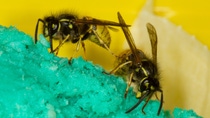Media
BASF supports community-led project to defend New Zealand’s native wildlife
- Supports Nelson-Tasman region’s Wasp Wipeout project
- NZ$22,000 sponsorship for 2017 and 2018 campaigns
Nelson, New Zealand – 2 March, 2017 – BASF, the world’s leading chemical company, has sponsored the Wasp Wipeout program taking place in the Nelson-Tasman region of New Zealand. Wasp Wipeout is a community-led conservation project that aims to significantly reduce German wasp and common wasp populations in the Nelson-Tasman region.
BASF will provide just over NZ$22,000 to support the project’s summer campaigns in 2017 and 2018. In New Zealand, wasps pose a serious threat to the biodiversity of the ecosystem, harming native birds and insects and competing for food with native species. They are estimated to cost the economy more than NZ$130 million per year, causing damage to primary industries and posing a significant threat to human health and outdoor recreational activities.
The control method adopted by the project, and approved for public use, utilises the protein-based wasp bait Vespex®, produced by a local company, Merchento, using BASF’s insecticide, fipronil. The resulting wasp bait is making a significant difference in the fight against these costly pests. The protein-based bait targets only wasps and is not attractive to non-target insects including bees. BASF worked closely with Merchento and the New Zealand Department of Conservation to develop procedures to ensure good stewardship around the use of the product.
David Hawkins, Managing Director and Chairman of BASF Australia and New Zealand, said “The protection of biodiversity is an important part of BASF’s commitment to sustainability. We are pleased to have been able to use our expertise to combat a problem that negatively impacts not only biodiversity, but public health and the economy.”
Vespex is currently the only available tool for the cost-effective management of wasp populations across wide areas where it is impractical to locate and destroy individual nests.
fipronil, the active ingredient of the bait, is a broad-spectrum insecticide that disrupts the central nervous system of the insect. It is used at a low concentration in the bait, which allows the wasp time to return to and contaminate the nest before succumbing to the poison. The use of fipronil in wasp baiting has been shown to be extremely effective in controlling wasps in large scale trials conducted by the Department of Conservation in the Nelson-Tasman region. BASF has worked to ensure the adoption of good stewardship practices with the use of Vespex bait so that native species are protected.
The Wasp Wipeout project involves a number of local organizations including the Nelson Mail newspaper, the New Zealand Department of Conservation, the Tasman Environmental Trust, Nelson City Council, Tasman District Council and various community groups. The program invites local residents and organisations to have their areas baited by an approved user and volunteers. The program will be completed over an intensive baiting period this February in an attempt to eradicate wasps from the region.

